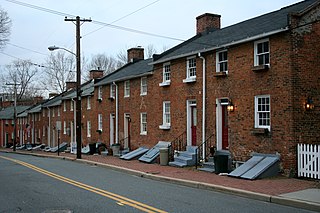
Oella is a mill town on the Patapsco River in western Baltimore County, Maryland, United States, located between Catonsville and Ellicott City. It is a 19th-century village of millworkers' homes.

The Emerson Tower is a 15-story, 88 m (289 ft) clock tower erected in 1907–1911 at 21 South Eutaw Street, at the northeast corner of Eutaw and West Lombard Streets in downtown Baltimore, Maryland. It was the tallest building in the city from 1911 to 1923, until supplanted by the Citizens National Bank building at the southeast corner of Light and Redwood (German) Streets. It was designed by local architect Joseph Evans Sperry (1854-1930) for Isaac Edward Emerson (1859-1931), who invented the Bromo-Seltzer headache remedy.

The Alex. Brown & Sons building is a historical structure located at 135 East Baltimore Street in Baltimore, Maryland. During the 20th century it served as the corporate headquarters for the banking firm Alex. Brown & Sons, the oldest in the United States when it was purchased by Bankers Trust in 1997. The two-story building, completed in 1901 and designed by the partnership of J. Harleston Parker and Douglas H. Thomas. Jr., survived the 1904 Baltimore fire. The building was modified on the Calvert Street side and in the interior by the firm Beecher, Friz, and Gregg in 1905.

Silver Spring station is a former train station on the Metropolitan Subdivision in Silver Spring in Montgomery County, Maryland. It was built in 1945 by the Baltimore and Ohio Railroad on the foundation of a previous station, a Victorian-style brick structure built in 1878. It served intercity trains until 1986 and commuter rail until 2000. Today, it is owned and operated as a museum by Montgomery Preservation, Inc., a non-profit organization.
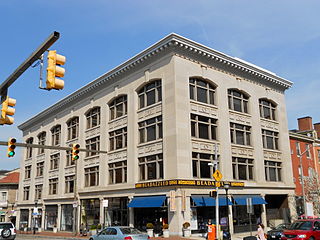
Benson Building, also known as the IPC Building, is a historic retail and office located at Baltimore, Maryland, United States. It is on the corner of East Franklin and North Charles Streets. The main side is on Charles Street and has seven bays with store windows and entrances on the first floor, and office windows on the upper floors. The recessed storefronts feature bronzed aluminum infill panels above and below the glass panes. It was constructed in 1911 and the principal original occupant was C.J. Benson and Company, a local interior decorating and furniture establishment.

Building at 409 West Baltimore Street, also known as the N. Hess & Bro. Building, is a historic retail and wholesale building located at Baltimore, Maryland, United States. It is a four-story brick commercial building with a cast-iron façade above an altered storefront, erected about 1875. Built originally for a wholesale grocery company, it was subsequently occupied by a boot and shoe factory, and a series of wholesale and retail dry goods or clothing stores.

George Knipp & Brother Building is a historic retail building located at Baltimore, Maryland, United States. It is a five-story brick commercial structure with a four-bay cast-iron façade, constructed about 1875. It features large window openings flanked by Corinthian columns. It was originally the location of John Knipps’ furniture business and his brother George Knipp's enterprise in gas fixtures and plumbing supplies. It was later occupied by a furniture and carpet firm and later a J.G. McCrory Co. store.

Heiser, Rosenfeld, and Strauss Buildings, also known as Inner Harbor Lofts I, is a historic loft building located at Baltimore, Maryland, United States. It is a complex of three structures. The Heiser Building is a Romanesque Revival style, six-story brick, stone, and iron structure, eight bays wide and 14 bays deep, built as a show factory in 1886. The Rosenfeld Building is a six-story, five-bay loft building, with Beaux Arts styling and built for E. Rosenfeld and Company in 1905. The Strauss Building is a six-story high, six-bay wide, and 11-bay deep loft structure built in 1887 for the Kinny Tobacco Company, cigarette manufacturers, and later occupied by the Strauss Brothers, clothing manufacturers and became part of the Rosenfeld complex around 1910.

Gunther Brewing Company is a historic brewery industrial building complex, located in the Canton neighborhood of southeast Baltimore, Maryland,. The site comprises 15 masonry buildings. The main structure is a five-story brick L-shaped Romanesque Revival-style brew house with a two-story brick ice plant built about 1910 and one- and two-story boiler room. Additional brew houses built in 1936 and 1950 are also on the property. The later Tulkoff factory and warehouse was built about 1964. It was home to the George Gunther, Jr. Brewing Company, founded in 1900. By 1959, it was the second largest brewery in Baltimore, one of the major centers of brewing in America, when it produced 800,000 barrels per year and employed approximately 600 people. Hamm's Brewing Company bought the Gunther Brewing Company in 1960, and later became part of Miller Brewing Company. The brand was acquired just three years later by the F. & M. Schaefer Brewing Company in 1963, the plant in Canton was closed in 1978. The Tulkoff company briefly used the factory for their sauce products at the conclusion of all brewing operations.

H.F. Miller & Son Tin Box and Can Manufacturing Plant, or the American Can Company, Miller Factory, and now Miller Court is a historic can manufacturing plant located at Baltimore, Maryland, United States. It was erected in three stages between 1890 and about 1910. It is a four-story brick manufacturing plant. The exterior features decorative brickwork, multiple window forms, and substantial construction typical of the period. The interior features chamfered posts, closely spaced joists, and fire doors.
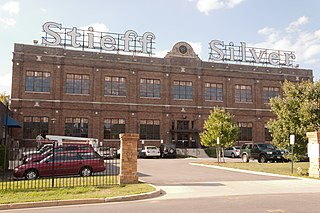
Stieff Silver Company Factory is a historic silver factory located at Baltimore, Maryland, United States. It is a two-story nine-bay rectangular brick factory building, designed by Theodore Wells Pietsch and built in two stages in 1925 and 1929. The exterior features a lighted sign flanking a central clock that rises above a parapeted roof. The Stieff Silver Company was the last of the Baltimore silverware manufacturers, operating between 1892 and 1999.

Coca-Cola Baltimore Branch Factory is a historic factory complex located at Baltimore, Maryland, United States. It was constructed from 1921 to 1948 and built principally to house Coca-Cola's syrup-making operations. The complex is spread over a 9.4-acre (38,000 m2) site and includes a two-story brick syrup factory/sugar warehouse and an earlier two-story brick mattress factory that Coca-Cola acquired and adapted in the 1930s. Completed in 1948, the complex housed syrup-making operations as well as the Coca-Cola Company's chemistry department.

Maryland White Lead Works is a historic lead paint factory complex located at Baltimore, Maryland, United States. It is a U-shaped industrial complex constructed about 1867. It consists of nine interconnected brick and wood-frame buildings, which vary in height from one to four stories, surrounding a yard. The complex includes the powerhouse, two production sheds, a manufactory loft with an office wing, and a service building. The Maryland White Lead Company occupied the site from 1867 to 1896, Baltimore's first and most substantial manufacturer of lead paints.

National Enameling and Stamping Company is a historic factory complex located at Baltimore, Maryland, United States. It was constructed in 1887 to serve as the works of the Baltimore branch of the nation's largest tinware manufacturer, the National Enameling and Stamping Company (NESCO). The densely packed complex fills an almost 5-acre (2.0 ha) site and consists of 17 interconnected buildings and one structure that vary in height from one to five stories. The complex was organized to house three primary functions in discrete sections: the manufacture of tinware, the manufacture of enameled and japanned wares, and storage, warehousing, and distribution. The plant ceased production of tinware and enameled wares in 1952.
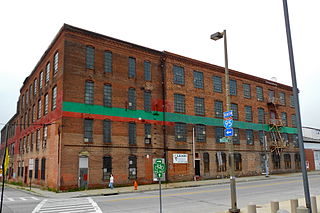
Parker Metal Decoration Company Plant is a historic factory building located at Baltimore, Maryland, United States. It is a steel-frame brick industrial building, ranging from one to three stories in height, and consists of five components built in stages between the first decade of the 20th century and the 1940s. The Parker Metal Decorating Company operated between 1921 and 1994.
Procter and Gamble Baltimore Plant is a historic factory complex located at Locust Point in Baltimore, Maryland, United States. It is a compact industrial complex built by the national corporation Procter & Gamble comprising five major three-story brick buildings spread over 10 acres (40,000 m2). These major buildings are the Process Building (1929), the Soap Chip Building (1929), the Bar Soap Building (1929), the Warehouse (1929), and the Tide Building (1949).

Equitable Gas Works is a historic gas works located at Baltimore, Maryland, United States. It is a U-shaped complex occupying an entire city block and consisting of five 1882-1883 Romanesque Revival painted brick buildings ranging from one to two stories in height and one 1947 office building adjacent to CSX tracks in Spring Gardens, an industrial precinct in South Baltimore, Maryland.

South Central Avenue Historic District is a national historic district in Baltimore, Maryland, United States. It contains brick two- and three-story industrial and residential buildings reflecting over 150 years of utilitarian adaptation of buildings and space. The district includes early 19th century rowhouses, late 19th century and early 20th century manufacturing and warehouse buildings, gas stations, stables, car barns, commercial/residential buildings, and corner stores. Several larger buildings are the Bagby Furniture Company Building, the Strauss Malt House, and the Alameda School. Many rowhouses have been covered with formstone.
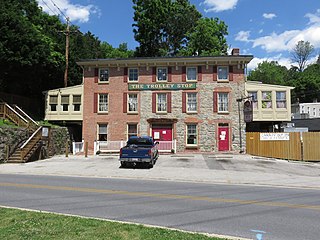
Ellicott's Mills Historic District is a national historic district at Oella, Baltimore County, Maryland, United States. It is on the east bank of the Patapsco River, opposite Ellicott City. This historic district designation relates to the industrial operations of the Ellicott family from the 1770s through the mid-19th century. It consists of the sites of historic buildings including: an 18th-century building, a section of an 18th-century mill incorporated in a 20th-century factory, a 19th-century tavern, 19th-century workers housing, and an 1859 Italianate villa built by John Ellicott. Historically, these industrious mills were served by the major east–west route in Maryland during the early 19th century, the old National Pike. Also in the district is the mammoth multi-story Wilkins-Rogers Company flour plant, which is located on the site of the 1792 Ellicott Flour Mill, the first merchant flour mill in the United States.
The Union Bros. Furniture Company, also known as the Plymouth Wallpaper Building, is a historic building located in Baltimore, Maryland, United States. It is composed of three sections that were built at three different times between 1923 and 1955. Each section reflects a distinct architectural style and construction techniques from the city's industrial architectural history. The oldest section, completed in 1923, is a utilitarian design that consists of simple brick walls and timber framing with punched openings for the windows. The second section utilized poured-in-place concrete construction techniques. The third section, completed in 1955, is a single-story mid-century modern structure that consists of brick load bearing walls that are spanned by steel beams. It features more elaborate brick detailing than the other two sections and it features a streamlined aluminum entrance canopy.























